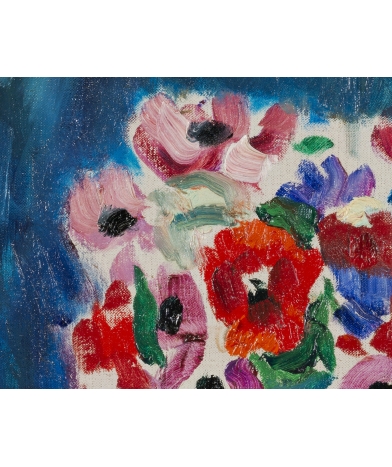Charles Camoin (1879-1965) - Fruit bowl and flower vase
Oil on canvas, signed lower left
Dimensions : H. 65 x L. 54 cm (with frame : H.91 x L. 80)
Born in Marseille in 1879, Charles Camoin was one of the key painters who marked the transition from the 19th to the 20th century. He was very close to Matisse, Manguin and Marquet, whom he met in Gustave Moreau's studio at the Beaux-Arts in Paris. With them, he took part in the "Cage aux fauves" at the Salon d'Automne in 1905. This Fauve artist quickly achieved success, exhibiting regularly in Parisian and European salons. Although Camoin's work favoured the expression of colour, it always remained attached to the transcription of the motif and its variations in light. From this point of view, Charles Camoin is "the most impressionist of the Fauves", as Bernard Dorival wrote.
In his time, Camoin was also the messenger of Paul Cézanne's doctrine. His encounter with the master from Aix, to whom he had the deepest and most profound admiration, left a lasting impression on him. The close ties he forged with Cézanne and the letters he received from him mark his main contribution to the history of art during this period. From a personal point of view, this meeting determined for a long time the originality of Camoin's art, which tended to reconcile the spontaneity of the coloured gesture with the order of the motif.
After the war, Camoin divided his life between his studio in Montmartre and Saint-Tropez, where he settled in 1921, increasingly affirming his taste for sensual, voluptuous and spontaneous painting, marked by the presence of Renoir, whom he visited in 1918. Throughout his life, he remained attached to his favourite themes, landscapes of the Midi, portraits of women, still lifes and nudes.
"As a colourist, I have always been and still am a fauve on the loose". Charles Camoin.
This superb still life immerses us in Camoin's Modern art, which was inspired by the greatest post-impressionist painters. The composition is totally Cézanian, while the extremely refined drawing plunges us into the world of Matisse. In this emblematic work, the power of colour is Charles Camoin's true signature, his pictorial language. As he himself said after the end of Fauvism in the strict sense, Camoin has produced here a purely Fauvist painting.
Museums :
New York Metropolitan Museum of Art & Moma, Madrid Musée Thyssen-Bornemisza, Nice Musée des Beaux-Arts, Paris Musée national d'art moderne et Musée de Montmartre, ...






